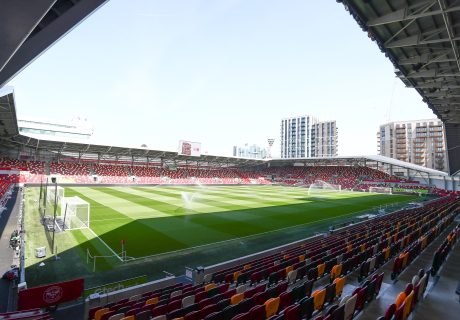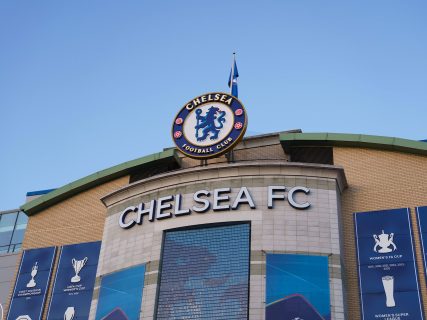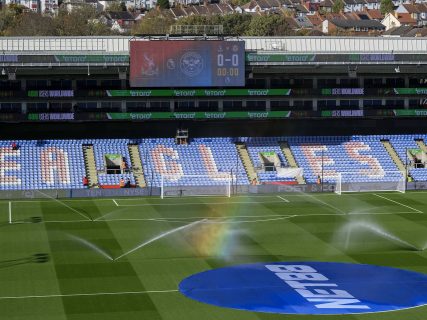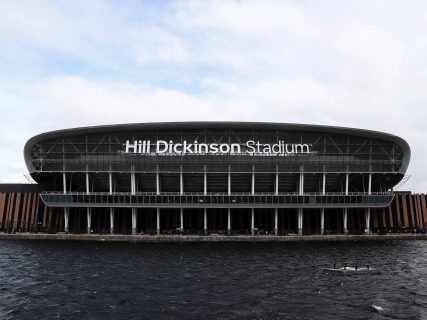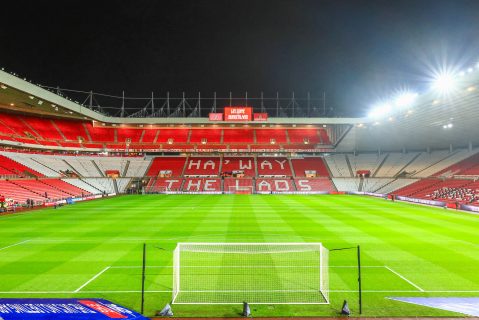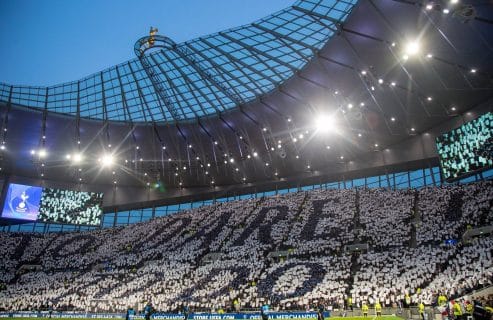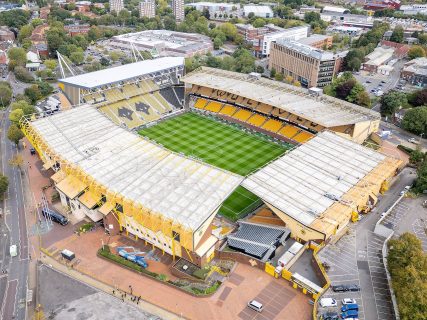Overview of Premier League Stadiums
As the richest football league in the world by some distance, it’s to be expected that various Premier League stadiums will also be some of the best and biggest on the planet. Whether it’s the sheer capacity supported, the general aesthetics or the price tag of these stadiums, each and every one of them has something to shout about.
Furthermore, we’d like to highlight some of the main facts for each of the Premier League grounds ahead of the 2025-26 season, like the fact that this will be the first season for Everton at their new stadium as they say goodbye to Goodison Park, their home ground for more than a century.
As you will see as we run through the clubs, some have existed for well over 100 years, and some were constructed as recently as the last decade. This means that the Premier League has a broad spectrum of stadium sizes and designs, which is pretty cool.
That being said, even the old stadiums are regularly refreshed to adhere to modern standards necessary for participation in one of the best football leagues in the world.
Now, in no particular order, let’s get started.
Etihad Stadium – Manchester City
The Etihad Stadium is home to Manchester City, the most successful English team over the past decade.
Although this stadium is home to one of the most successful teams, it’s actually only the sixth biggest in Premier League football. However, that will all change in the coming months once the North Stand expansion is complete, to move the stadium’s capacity past the 60,000 mark.
Elland Road – Leeds United
Elland Road is one of the most well-known stadiums in the UK due to Leeds United’s past success there. Leeds United has been at Elland Road for 105 years and has won twelve trophies in that time. It has also played host to European matches in the 1960s and 1970s.
There was talk in 2019 of possibly increasing the capacity at Elland Road from just under 38,000 to 55,000, and expansion plans were finally officially confirmed six year later in 2025.
Anfield – Liverpool
Anfield has always been one of the most iconic stadiums in English football, and over the past five years, that has been more evident than ever.
These days, Anfield can support more than 60,000 spectators for any single game, and the stadium is one of the few that has remained in the exact same sport ever since it opened – all the way back in 1884.
Villa Park – Aston Villa
Having been constructed in the 19th Century, Villa Park is one of the Premier League stadiums that just radiates tradition. Amazingly, when this stadium was built in 1897, it was done so for less than £17,000, which is a little over £25 million in today’s money.
The stadium isn’t one of the biggest in the league, with a capacity of just over 40,000, even though Villa Park registered more than 75,000 attendees (before safety measures were introduced).
Old Trafford – Manchester United
Few stadiums carry a more significant reputation than Old Trafford. This stadium has seen legends of the football world over the years, from Sir Alex Ferguson to Cristiano Ronaldo. Therefore, it seems fitting that Old Trafford is the biggest stadium for club football in England, with a maximum capacity of more than 74,000.
In addition, Old Trafford has one of the best nicknames of any other club—The Theatre of Dreams! Of course, this was the nickname handed to the stadium by the legendary Sir Bobby Charlton.
It seems increidble to say, but Man Utd will leave Old Trafford in the next decade, with plans confirmed for a new 100,000-seater stadium.
Emirates Stadium – Arsenal
With Emirates being a massive and very successful company, it’s no great surprise to see the price tag of this stadium – more than £390 million. To be fair, this does justify the investment for a club the size of Arsenal, and the Emirates Stadium can host over 60,000 spectators at a time due to its size.
Interestingly, if Wenger and other Arsenal executives had not decided to relocate the club, The Emirates would never have come into existence. That said, we are certainly glad that this decision was made, as this is undoubtedly one of the most appealing stadiums in the Premier League.
St James’ Park – Newcastle United
Ever since 1892, St James’s Park has been the home of Newcastle United, one of the Premier League’s most popular teams. This one is again owned by the local council, and when full, St James’s Park can accommodate just over 52,000 fans.
While the stadium has been expanded previously, a series of internal arguments have ultimately resulted in its rather unique appearance. Nicknamed the Castle on the Hill by locals, St James’ Park is a must-visit.
Craven Cottage – Fulham
Out of all the Premier League stadiums, Craven Cottage has one of the lowest maximum capacities. When full, it can only accommodate 19,359 spectators, which creates a rather intimate feel about the ground.
It’s not all bad at Craven Cottage, however, as the venue itself actually has a bit of Royal history going back more than 3 Centuries, which is something that not many Premier League grounds can boast.
Turf Moor – Burnley
When it comes to stadiums with a lot of history, Burnley’s Turf Moor certainly has it in abundance. While the stadium held its first football match in 1883, it had already been hosting cricket matches for 40 years.
Today, Turf Moor is a modern stadium with a capacity of 22,546 seats.
Gtech Community Stadium – Brentford
In contrast to many historical grounds in the Premier League, Brentford have the newest stadium in the entire league. Gtech Community Stadium was built in 2020 and Brentford have moved here from their old ground Griffin Park.
Although this stadium has a small capacity—just 17,250 seats—it is an ultra-modern facility that certainly belongs in the Premier League.
London Stadium – West Ham United
West Ham United has played its home games at the London Stadium since 2016. The stadium can hold up to 60,000 spectators for football games. Interestingly, the terms of the lease dictate that this capacity can be increased depending on the sport—go figure that one!
That said, London Stadium has played host to cricket, baseball, and even high-profile rugby games, so it’s not just football that plays here.
Selhurst Park – Crystal Palace
Selhurst Park was shared between Crystal Palace and Wimbledon FC until 2003. The stadium first opened in 1924, but it has since experienced a few expansions. While no official cost has been provided for the expansions, the initial construction cost was just £30,000!
These days, it’s only Crystal Palace who play there, and the stadium capacity is a little over 25,000, which is still quite small for a Premier League club. If you are ever in London, Selhurst Park is an iconic stadium to visit.
Tottenham Hotspur Stadium – Tottenham Hotspur
This is one of the newest and most impressive stadiums in Premier League football. Construction was completed in 2019, and upon finishing the project, the Tottenham Hotspur Stadium became the biggest in London.
It even has a fully interchangeable pitch for when the NFL comes to town, which is pretty unique. We hope you’re sitting down too – the total project cost for this one was £1 billion! So, it’s definitely worth checking out this modern marvel if you’re ever in London.
Stamford Bridge – Chelsea
‘The Bridge’, as it is commonly referred to, has been home to some seriously impressive football over the years. Of course, Chelsea have managed to win the Premier League, Champions League, and a bunch of other competitions over the years. Therefore, it would be fitting for Stamford Bridge to be as good as it is.
While the current capacity allows for just over 40,000 fans, the club plans to increase this by 50% in just a few years, therefore allowing for up to 60,000 fans per game! Given the club’s popularity in London, the stadium would still likely sell out, too!
Molineux Stadium – Wolverhampton Wanderers
Molineux Stadium was also built before the 1900s, making it another stadium with an impressive history. It has stayed true to its original purpose, which was to allow Wolverhampton Wanderers to play professional football.
This means that the one and only permanent occupant since inception has been Wolves, and this is a true credit to how the team has stood the test of time. It’s a good reason to add it to your stadium visit list, even if you are not a fan.
American Express Community Stadium – Brighton
When Brighton made the surge towards Premier League football, it only made sense for the club to build a stadium that would reflect this. That’s why, in 2011, Brighton built a £93 million stadium, which is definitely one of the largest investments made outside of the top clubs in the Premier League. But as you may know, although the club anticipated top-flight football, Brighton didn’t actually make it into the Premier League until the 2016/2017 season.
With that said, it’s clear that the gamble paid off, as the club regularly sees more than 25,000 fans in attendance for home games these days. The American Express Community Stadium is an impressive one, and if you fancy a trip down South, don’t miss out on visiting Amex Stadium since it’s worth the trip.
Vitality Stadium – Bournemouth
While Vitality Stadium is the smallest stadium in the Premier League, with a seating capacity of just above 11,000, it certainly has its charm. After all, the stadium first opened more than a century ago, in 1910, so there’s a lot of history surrounding it.
That being said, the stadium was completely rebuilt in 2001, so it is a modern ground suitable for a Premier League club such as Bournemouth.
City Ground – Nottingham Forest Stadium
Opened in 1898, just at the turn of the 20th century, City Ground is one of the oldest stadiums in England. It has seen plenty of legendary games and famous European nights in years when Nottingham Forest ruled the continent.
With a capacity of 30,445, it is among the league’s smaller stadiums, but the Reds plan to expand the stadium soon.
Stadium of Light – Sunderland
Since the Stadium of Light is one of the biggest stadiums in England, it was sad to see it in League One for a few years. However, Sunderland are now back in the Premier League and we’ll once again see the Stadium of Light in its full glory.
When 100% full, this ground can host up to 45,000 spectators. Although the stadium was first opened in 1997, it quickly received additional investment for expansion, which occurred in 2000—much to the delight of Sunderland fans.
Hill Dickinson Stadium – Everton
Since the news of Everton’s new stadium being planned broke, the team’s fans have been in a constant state of excitement. After all, it was clear from the start that the new stadium, planned to be built at Bramley-Moore Dock, would be a state-of-the-art ground.
So, as much as everyone is sad to say goodbye to Goodison Park, a new chapter in Everton’s history is here. Starting from the 2025-26 season, the team will play at the Hill Dickinson Stadium, which has a capacity of 52,888 seats.


